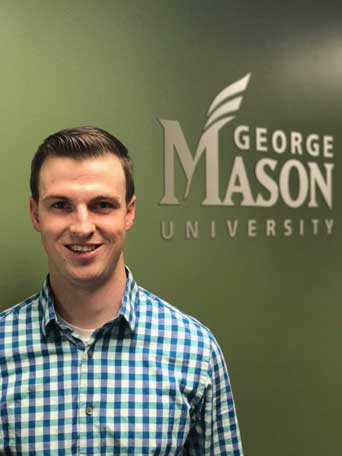
Terrence Moran. Provided photo
Here is what Terrence Moran loves about civil engineering:
“We build big things,” he said. “There are deliverables you can see. You design a bridge, and it’s there for 50 or 70 years. There’s that sort of payoff.”
For Moran, a senior majoring in civil and infrastructure engineering in George Mason University’s Volgenau School of Engineering, the payoffs, so far, have been more personal.
He is thriving in an academic pursuit people told him was too difficult. He is doing research with assistant professor David Lattanzi using a technology that can basically peer inside steel, and he will pursue his master’s degree and PhD at Cornell University with a fellowship from its School of Civil and Environmental Engineering.
Moran also received fellowship offers from Stanford and the University of Texas, he said.
“Whether it’s his homework or analyzing lab results, he never stops pushing himself until he’s met his goals and mastered a topic,” Lattanzi said. “I’ve been fortunate to work with a lot of bright students, but none as tenacious as Terrance. That’s why he represents the best of Mason.”
After four years as an infantryman in the Marines and two deployments in Afghanistan, Moran, who left active duty in 2012 as a lance corporal, was working on a Virginia road crew, digging trenches and laying electrical conduit. One day, he said, he noticed someone at the site wearing a polo shirt and looking not nearly as sweaty and dirty as he and his workmates were.
“I was, like, ‘What does he do?’ ” Moran recalled.
The individual was an engineer, and though Moran said he did not speak to him, he investigated his duties and discovered two subjects he loves, physics and math, are involved.
Still, he said, friends told him engineering was too tough and to try a different profession. Instead, Moran dove in, and after a year at Northern Virginia Community College, transferred to George Mason using the GI Bill.
“Mason has been fantastic,” said Moran, whose fiancée, Alison Mann, will graduate this month with a master’s degree in biodefense in Mason’s Schar School of Policy and Government. “You get out of it what you put in. If you want to come here and go to classes, that’s fine. But if you really want to, you can do more. It can open a lot of doors for you.”
Working with Lattanzi and a $1,000 grant from Mason’s Office of Student Scholarship, Creative Activities and Research, Moran is using digital imaging to examine the effects of corrosion in steel.
“It’s pretty cool,” Moran said of the process. “It builds a model with stereoscopic cameras as we pull apart the steel so we can see strain and stress in two dimensions. It’s cutting-edge technology. It kind of paved my way to these top-tiered schools.”
And helps build big things.
